
The morning of my last day here, we made our way to Saint Patrick’s Cathedral, which is a giant Neo-Gothic cathedral that takes up an entire city block on 5th Avenue between 50th and 51st Streets. It’s a new cathedral completed in 1878, but it is a marvelous sight to behold nonetheless. I always love visiting cathedrals and churches (Westminster Abbey in London was a particular delight), and I’m not sure why. It seems so silly to visit a building devoted to all these mythological characters that so many deluded people still think are actually real. I suppose that even though it’s all made up, it’s quite impressive that such a ridiculous business could inspire all this architecture, art, and music. Humans are good at making things up out of thin air, after all.

Saint Patrick’s is the largest Neo-Gothic Catholic cathedral in North America, as it can accommodate 3000 people. The structure has all the classic elements of a cathedral, and the whole building is intricately designed in marble. Positioned at the usual spot at the apse of the cathedral near the east end, the main altar sits atop a raised, square platform accessible by steps on all sides, and above the altar is a magnificent, golden ciborium (i.e. canopy) standing several feet tall. On the north and south walls of the nave are ten additional alters. The two most memorable altars were the Altar of the Holy Face (complete with one of those creepy images of Jesus looking depressed) and the Shrine of Our Lady of Czestochowa (a famous icon of the “virgin” Mary inspired by the shrine in Poland, a traditional image of a creepy and bored Mary gesturing with her right hand towards an equally creepy and bored baby Jesus held in her left arm). Additional altars continue along the east of the cathedral around the usual semicircular ambulatory, and at the very end of the east end is the traditional Lady Chapel.
We also happened to arrive while they were tuning the organ, which towers over the west end of the cathedral up in the choir loft. Tuning the organ is quite a task, as it has 7855 pipes, But, how I would love to attend a concert or Christmas mass at Saint Patrick’s to hear it played!
Following the cathedral, we made our way back to Greenwich Village to participate in the Original Greenwich Village Food and Culture Walking Tour. And, oh my goodness! What a tour! Before I say anything else about this tour, I just can’t recommend it enough! It was so, so good, and it was such a delight! I think it’s even underpriced at $54, selling itself short of its proper value.
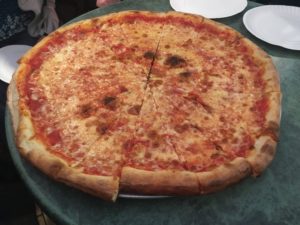
Our lovely tour guide was Robin, and she brought us to our first stop which was Joe’s Pizza. We all got to eat a classic New York slice of cheese pizza as she regaled us of the tail of how Joe himself is from Naples (still alive and kicking in his 80s) and how he learned how to make a New York style pizza using a high protein dough. She also told us of how New York pizzas and bagels get their signature taste because of how the city gets its water from the Catskill Mountains, and the combination of minerals in the water is unique to that area. (The tap water in New York really is quite good. Quite unnecessary to buy anything out of a wasteful plastic bottle.)
Following Joe’s, we made our way to O & Co., a boutique on Bleecker Street that sells top-of-the-line olive oil from Mane, France. As we sampled the best olive oil I have ever tasted (one infused with basil and sprinkled over a slice of a baguette from Amy’s Bakery and one infused with truffles and sprinkled over popcorn), we learned about all the shams of the olive oil industry. You’ll be depressed to know that only 18% of the oil in a bottle of extra virgin olive oil needs to be extra virgin in order to allow companies to advertise the bottle as containing extra virgin olive oil (extra virgin refers to oil that comes from the first pressing of the olive). You’ll also be depressed to learn that companies can say that their olive oil is a product of Italy as long as something of the their product comes from Italy (which might just be the cap of the bottle, by the way). Furthermore, any olive oil that comes in a transparent container like a plastic jug or dark green glass bottle is of the lowest grade because light affects the quality of the oil. Lastly, we discovered that you just should never buy canola oil, and that if you must cook with a high temperature oil, use avocado oil instead.
So, how can you be sure you are buying actual, real, worthwhile olive oil? Basically, you gotta to go an olive oil dealer like O & Co. to make sure you’re buying the best. Prepare yourself for sticker shock, though, as actual, real, worthwhile olive oil is expensive. But, it is so, so good!

After taking a break from the rain at the Cornelia Street Cafe (we didn’t have a chance to try any of their food, but we got to see their underground, speak-easy style basement where over 700 shows happen in a year with poetry readings being especially common), we headed over to Faicco’s (a family-run Italian style deli that has been around for over 100 years) where we sampled their famous Sicilian rice balls. These delectable delights consisted of a delicate combination of rice and cheese and seasonings shaped into a ball, coated with bread crumbs, and then fried. Do go check out Faicco’s when you’re in New York, as you won’t be disappointed. (It goes without saying that every place I’m mentioning on this tour is worth going out of your way for, with the exception of possibly one that I’ll point out below.)
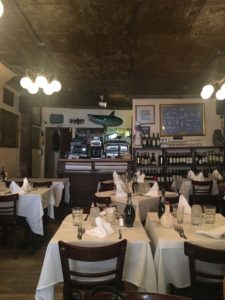
So much more to see as we carried onwards to Trattoria Pesce Pasta, a restaurant specializing in Northern Italian fare in a fine dining environment. It’s housed in a building that still has its original copper ceiling that I couldn’t stop staring at in admiration. However, my attention was quickly drawn away from the ceiling and towards the food as they all brought us our own meatball with red sauce. The size of a baseball, this meatball was the best meatball I’ve ever had, the meat provided by the nearby meat market, Ottomanelli Brothers. Everything on this tour was the best example of whatever it was we were eating, I must say, and I would love, love, love to come back to New York to experience a night of fine dining at Pesce Pasta and rack up a bill of a couple hundred dollars. I think it’d be well worth it.
Our next stop (with a slight detour past the Doughnut Project which wasn’t included on our tour but is included on others, and how I wish I could’ve sampled one of their doughnuts while we were there; so little time, you see) was the Italian restaurant called Rafele. Another example of Italian fine dining similar to Pesce Pasta except in a more open space compared to Pesce Pasta’s delightfully close quarters, we got to try their eggplant rollatini with a glass of chianti. Of all the foods we tried on this tour, I must actually admit that this rollatini (while quite good), didn’t impress as much as the other foods we tried. I think I’d much sooner rather return to Pesce Pasta over Rafele.
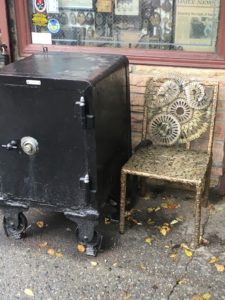
Before our tour concluded with three more stops, we went on some side quests to take a look at a few landmarks including Greenwich Locksmiths, a tiny, tiny building whimsically adorned with thousands of keys on its front-facing facade; Manhattan’s narrowest house located at 75-1/2 Bedford Street where previous residents included actor Cary Grant and poet Edna St. Vincent Millay, among others; Chumley’s, a speakeasy dating from 1922 and whose name bares a very similar resemblance to these cute robots from Doctor Who; Grove Court, a row of six, brick-faced townhouses tucked away between numbers 10 and 12 Grove Street; and Cherry Lane Theatre, a box factory converted into a theatre in 1924 and whose stage has been graced by Barbra Streisand, F. Murray Abraham, Beatrice Arthur, and so many others. We finished the afternoon touring Greenwich Village with a trip to Milk and Cookies Bakery, where we got to enjoy a chocolate chip cookie fresh out of their oven; a stop by Murray’s Cheese Shop where we sampled a lovely, lovely selection of cow, sheep, and goat cheeses; and then lastly a trip to Pasticceria Rocco, where we got to enjoy their cannoli, which is always made to order and so it’s never, ever stale from sitting on the shelf for hours.
If it’s not entirely obvious by now based on how much I’ve gushed about this tour, do please go check out the Original Greenwich Village Food and Culture Walking Tour. It was such a joy to listen to our tour guide Robin tell us about all the food we were eating and all the buildings we were visiting. Even my seemingly thorough and overly detailed recollection of the tour is leaving out so many more specifics that I just can’t all fit in.
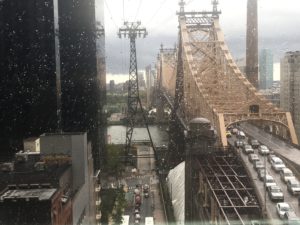
Feeling quite full from the food tour (I’d recommend going on an empty stomach, as you’ll get to eat plenty of food), we headed towards Roosevelt Island via the Roosevelt Island Tramway. Riders enter a large car that can hold 125 people. Suspended by cables at a height of 250 feet at its highest point, it travels under 20 miles per hour to travel 3100 feet (some of that distance over the East River) from the Upper East Side in Manhattan to the island. The ride provides fantastic views of the Queensboro Bridge, Manhattan, and the river itself. While its possible to get to Roosevelt Island by subway, I highly recommend going out of your way to enjoy the more scenic route that the tramway provides.

While on Roosevelt Island, we sought out the ruined Smallpox Hospital. The main building opened in 1865 and was designed in Gothic Revival style by James Renwick Jr. The two wings, designed in matching style, were built decades later in the early 20th century, the south wing designed by York & Sawyer and the north by Renwick, Aspinwall & Owen. As the name suggests, the hospital was used for individuals who contracted smallpox, as the isolated location on Roosevelt Island helped to quarantine the disease. This building offers a fascinating glimpse into the past, and I wish I could’ve walked around on the inside, but the whole site is closed off by a wrought iron fence as the structure, obviously, isn’t stable.
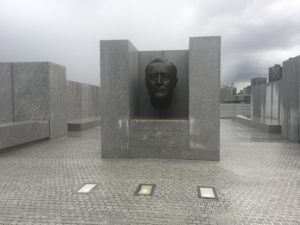
While on the island, we also admired the nearby Franklin Delano Roosevelt Four Freedoms Park. The park is a modest triangular space of 4 acres, an open green space flanked by a double row of little leaf linden trees. Near the southernmost tip of the park at the end of the island stands a grand, metal bust of Roosevelt that seems to hover within a stately granite temple of sharp, square angles. On the back of the monument is inscribed a section of Roosevelt’s State of the Union address to Congress in 1941. And in these days where we have a president and a Republican party that has attacked, undermined, disregarded, and denigrated the very foundations of American democracy, it’s important to repeat Roosevelt’s words here:
“In the future days which we seek to make secure, we look forward to a world founded upon four essential human freedoms. The first is freedom of speech and expression … everywhere in the world. The second is freedom of every person to worship god in his own way … everywhere in the world. The third is freedom from want … everywhere in the world. The fourth is freedom from fear … anywhere in the world. That is no vision of a distant millennium. It is a definite basis for a kind of world in our own time and generation.”
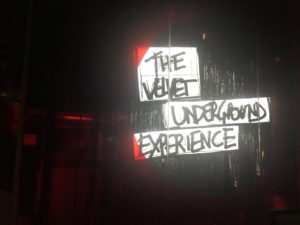 Evening was fast approaching by this point, and I had different plans from Amy and Aaron. They were off to enjoy Bruce Springsteen in concert (“He broke my heart and put it back together again,” Amy remarked following the sublime evening of music that I wish I could’ve attended), while I was off to the Velvet Underground Experience. The Velvet Underground is one of my all time favorite bands, so I was so excited that I was in New York when this exhibit was open. Except that, sadly, the whole experience rather left me feeling a little disappointed.
Evening was fast approaching by this point, and I had different plans from Amy and Aaron. They were off to enjoy Bruce Springsteen in concert (“He broke my heart and put it back together again,” Amy remarked following the sublime evening of music that I wish I could’ve attended), while I was off to the Velvet Underground Experience. The Velvet Underground is one of my all time favorite bands, so I was so excited that I was in New York when this exhibit was open. Except that, sadly, the whole experience rather left me feeling a little disappointed.
Even when staffed with the strongest team of researchers and curators, putting together an entire exhibit about the Velvet Underground would be terribly, terribly challenging. While the band itself was so, so influential on the music that succeeded them, very few physical artifacts exist from their initial existence from 1965 to 1973. That said, much of the exhibit exists as detailed placards, reprints of photographs, audio and video recordings, and the occasional signed album. And gosh, did they comb through every last artifact they could get their hands on. However, their striving towards an absolute, completionist aesthetic resulted in an exhibit that feels very, very schizophrenic as they tried to pack in every last little detail. Which might actually be appropriate since Lou Reed himself (as a video documentary in the exhibit informed us) was believed to have suffered from schizophrenia and who underwent electroshock therapy.
But, I would have preferred an exhibit that had a little more focus. For example, one of the first things we look at when we arrived is an exhaustive chronology smartly printed on a wall that detailed all the art and music that was happening during the 1960. Obviously, the 1960s were a tumultuous time that are difficult to sum up in a few words, but the chronology managed to cover everyone from Allan Ginsberg and James Earl Jones to Merce Cunningham and Edward Hopper. There was just so much to take in in so little space.
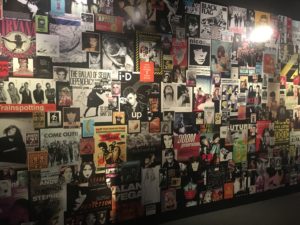
The main movers and shakers did get their own focused highlights in the form of giant books that you could flip through that were attached to brightly colored columns featuring enlarged photos of the individual in question. These individuals included (are you ready?): Lou Reed, John Cale, Sterling Morrison, Andy Warhol, Christa Päffgen, Moe Tucker, Gerard Malanga, Danny Williams, Edie Sedgwick, Angus MacLise, Candy Darling, Piero Heliczer, Barbara Rubin, Jonas Mekas, and La Monte Young (and possibly more, but I may have lost count). You could also view some short films as well, including Peyote Queen by Storm de Hirsch, Rockflow by Robert Cowan, Cat Lady by Tom Chomont, and Beatles Electronique by Nam June Paik.
But it was just all so much. So much information. Maybe these are all symptoms of my inability to focus my attention for longer than an hour in any museum, but there was just so much to take in in such a relatively small space. Then again, at the same time, I learned so much about one of my favorite bands, so I’m grateful for that.
My evening concluded with a yummy red curry at Hub Thai in the East Village and visits to some fantastic dive bars in the form of Doc Holliday’s and Manitoba’s before I met up again with Amy and Aaron at the disappointing Frank Restaurant.
And just like that, my time in New York came to a close as I set my alarm to wake up early the next day to arrive in time for my flight out of JFK back to Minneapolis. It’s always so easy to obsess over how sad it is when a vacation like this comes to an end. But, I do know that I will travel once again some day soon. And all my travels have taught me that it will always be fantastic. Absolutely fantastic. And the little bit of sadness I feel when it’s over is worth the fond memories I will always have of all my amazing, wonderful, and astonishing adventures on this ridiculous planet.
Stray Observations:
1. NYC often presents challenges in terms of readily finding a toilet. However, if there’s a church nearby, that’s probably your best bet to find a bathroom quickly.
2. While at O & Co, we also got to sample balsamic vinegar where we learned that real balsamic vinegar’s first ingredient on its list of ingredients should be grape must. Imitation balsamic vinegars tend to have red wine vinegar listed as their first ingredient.
3. The more I think about, the more I realize that I don’t think I could ever actually live in New York City. I love visiting, of course, but the city itself is so sloppy, so loud, so busy, and so covered in a thick film of sewer steam, dog piss, and garbage juice. Not something I want to be around every day but something I want to be around from time to time.
